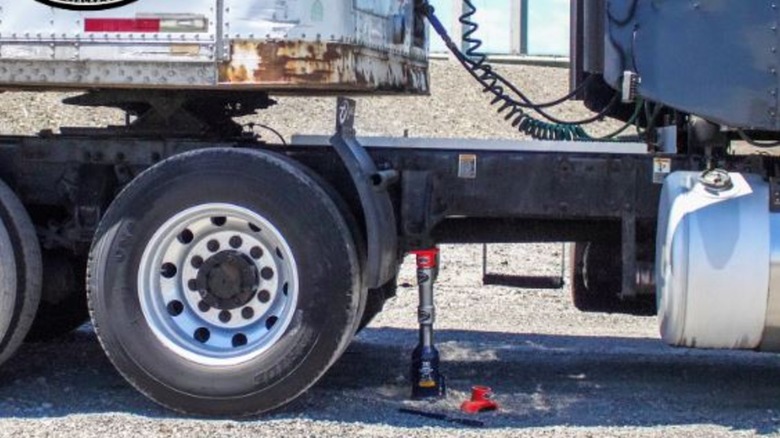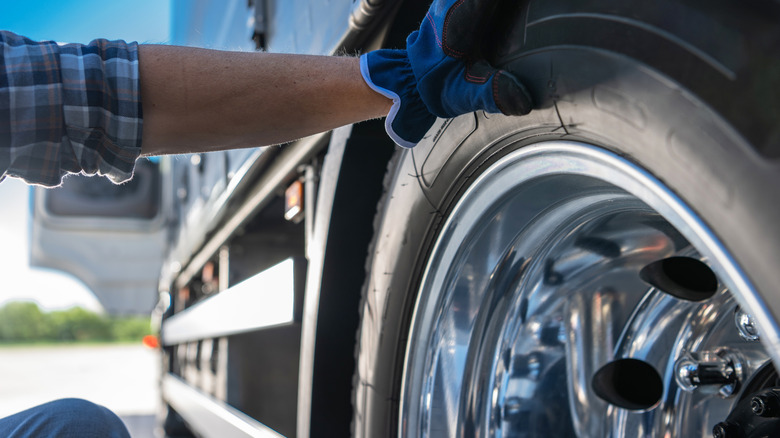How Are Heavy Semi-Trucks Jacked To Change Tires?
Semi-trucks are some of the longest, biggest, and heaviest vehicles on the roads. Semi-trucks — and here's what "semi" means on a semi-truck — are wide, averaging 8.5 feet, and can reach 70 to 80 feet long. An unloaded semi-truck can weigh 10,000 to 25,000 pounds, but when loaded with cargo, it can easily reach three times that weight. Because of their massive weight, semi-trucks use hydraulic jacks when they flat tires. These jacks are usually placed at specific reinforced positions on the frame that can bear the truck's weight.
Hydraulic jacks operate on the principle of Pascal's law to multiply force. Essentially, pressure is created when a hydraulic jack's lever is pumped, applying force on the fluid inside a chamber. The fluid transmits that pressure, which is then applied to the lifting mechanism. The two most common types of automotive jacks used on semi-trucks are the bottle jack and floor jack. Floor jacks are more portable because they have casters that make them easy to reposition during use. However, because the hydraulic cylinder on floor jacks is horizontally positioned, it's bulkier, which could be an issue if there is limited room.
In contrast, the cylinders on bottle jacks are installed vertically, and their simpler design enables them to lift heavier weights much higher. Additionally, bottle jacks are less expensive and are more compact and convenient. The disadvantage of bottle jacks is that they're less stable due to their narrow base.
Safety first, tire change second
Jacking up a semi-truck to change a tire starts with collecting the required tools and safety gear. These include a heavy-duty hydraulic jack, a torque wrench, wheel chocks, safety equipment — reflective vest, safety glasses and gloves — and a tire pressure gauge. Next, to ensure safety, the truck should be parked on a level surface, with the parking brake engaged and the chocks positioned on both sides of the wheels. Put on the safety gear and loosen, but don't remove, the lug nuts using the torque wrench.
Once the nuts are loosened, position the hydraulic jack at the jacking point closest to the tire being removed, then pump the jack until the tire is raised off the ground. When the tire is high enough, remove all of the lug nuts and carefully remove the tire from the axle. Then begin installing the spare tire by aligning the lug nut holes with the axle. Once fitted, place the nuts and use the torque wrench to tighten just enough that there are no gaps between the rim and the axle.
Slowly lower the hydraulic jack until the wheels are firmly on the ground. Next, use the torque wrench to fully tighten the nuts in a star pattern. Lastly, use the tire pressure gauge to check if the fitted tire is at the correct pounds per square inch, and add more air if needed to get the tire to the manufacturer's recommended level.
The cost of a flat tire on a semi-truck
As of 2022, 2.9 million semi-trucks were registered in the U.S., traveling across the country transporting everything from food to medicines and raw materials. On each of their trips, the threat of having a flat or punctured tire is present, a fact highlighted in a Fleet Financials survey of trucking companies reported at moderntiredealer.com that showed the average fleet of 112 trucks incurs an average of 97 flat tires per year.
Delays, including changing tires on a semi-truck, cost trucking companies money. When added together, a flat tire, driver, and vehicle downtime are computed as total downtime cost, which, according to the Fleet Financials survey, costs trucking companies an average $338.42 per flat. So a flat tire on a semi-truck must be replaced as soon as possible.
Having the right tools and equipment useful for repairing a flat tire helps minimize the delays. A hydraulic jack is indispensable since it offers the lifting capability required to raise the weight of a semi-truck and safely install the replacement wheel. Because hydraulic jacks can raise a semi-truck uniformly and safely, the process of removing and changing tires is made simpler and more efficient.


